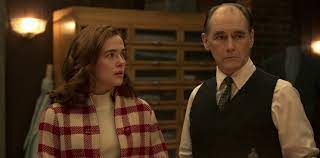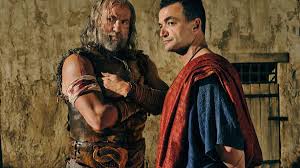The Outfit 2022 Movie Review
Graham Moore’s “The Outfit” funnels a sprawling 1950s gangster saga down into a single location. A middling thriller with occasional bursts of intensity, it’s told through the eyes and ears of elderly Englishman Leonard Burling (Mark Rylance), tailor to the mob and the film’s delightful centerpiece, who attempts to navigate the violent family drama from its margins. However, despite Rylance’s effective work and some smart physical staging, the film is ultimately unable to overcome its “tell, don’t show — then tell again” dialogue, layered atop an increasingly busy plot. The further it gets into its 105-minute running time, the more noticeable its seams become, distracting from an otherwise finely-textured fabric.
The pristine front of Burling’s Chicago shop is managed by his assistant Mable (Zoey Deutch), a surrogate daughter of sorts, who he hopes will take over the business, though she has aspirations of her own (a dynamic that just so happens to mirror “The Godfather”). Burling’s dingy workshop however, at the back of his store, doubles as a drop point for the Irish mob — led by Burling’s top customer, Roy Boyle (Simon Russell Beale) — who have set up a dedicated mailbox to deposit and retrieve covert communication.
The family’s button men are in and out all day, but Burling knows better than to glance in their direction. They do their work and they let him do his. This understanding is thrown into disarray when, one night, Boyle’s ambitious son Richie (Dylan O’Brien) shows up with a gnarly gunshot wound, as Boyle’s hot-headed right hand man Francis (Johnny Flynn) forces Burling to sew up the bleeding mob prince at gunpoint. Elsewhere in the city, a larger web of bullets and betrayals unfolds, constantly threatening to waltz into Burling’s workplace — which he soon learns might be under FBI surveillance.
Before “The Outfit” becomes a revolving-door drama, with new characters entering and exiting the scene, it begins as quietly and unassumingly as Burling himself. A student of London’s Savile Row, his methodical tailoring — or “cutting,” as he prefers to call it — is a treat for the senses. Close-ups of his finely-detailed craftsmanship are accompanied by soft voiceover as he lays out his methodology, and in the process, his outlook on his customers and the way he learns to read them. “You cannot make something good until you understand who you’re making it for,” he says.
In that vein, Moore tailors the film’s introductory montages for anyone who enjoys focused, functional popcorn cinema that doesn’t bend or apologize as it puts consummate professionals on display (great heist movies like “Ocean’s 11,” for example). When you put people who are good at their jobs on screen, and you present their work efficiently, you’re guaranteed an audience.
Unfortunately, “The Outfit” doesn’t stick to this initial clockwork feel for very long. Tailoring, it turns out, isn’t vital to the film’s visual or thematic approach — it’s more of a backdrop with mild historical significance: the first bug the FBI ever planted was in a tailor’s shop — and so Burling’s trade eventually falls by the wayside, along with the most enticing parts of Moore’s presentation.
What follows is not altogether uninteresting. The mob’s covert letters concern the aforementioned bug, a snitch who’s leaking secrets to a rival family, and the potential involvement of the Outfit, the influential crime syndicate created by the late Al Capone (the title is a cheeky double entendre befitting a thriller your parents might discover on Netflix). As it happens, Richie and Francis already have their suspicions as to the identity of the family’s rat, and it even appears Burling knows more than he’s letting on.
The answers aren’t as simple as they seem. At first, their increasing complications take the form of amusing surprises which help reveal more about each character. The problem, however, lies in the fact that once all the possibilities are in play, the film can’t help but stagnate, as it begins to rely on lengthy speeches intended as moments of soul-bearing honesty, but which all circle various plot functions first and foremost. Rather than being allowed the time to land with any kind of emotional impact, every puzzle-piece of spoken backstory is hastily retrofitted into the film’s quick-moving machine. While they may speed things along at first, it ensures that almost every ounce of humanity ends up in service of something mechanical, rather than emotional.
En route to this rote outcome, Moore is at least able to prevent new developments from feeling visually stale. The film is mostly limited to three rooms in Burling’s store — the reception area, the fitting room, and the back workshop, each connected by sliding doors — and since most of it unfolds in real time, it resembles a well-rehearsed stage play, with actors leaving and arriving on queue without too many lulls.
Despite the limited space, Moore, cinematographer Dick Pope and editor William Goldenberg make each shot feel new by ensuring its moment-to-moment function is crystal clear. A still beat is either one of silent reflection, as the frame holds on an unsteady confession, or one of building tension, as it cuts swiftly from Rylance’s shifting gaze to hidden objects and information scattered around the room (to which the audience is mostly privy). The action always has a sense of clarity, with blocking and lighting that keeps the geography of each sequence legible, enough that any movement from one room to the next is accompanied by anticipation. It’s basic, and simple, but this approach keeps the film moving rhythmically along — that is, until there’s little remaining tension or subtext off which its slick aesthetics can bounce.
Everyone involved is working at their optimum. Alexandre Desplat’s score is appropriately mischievous for a film that often plays like an exercise in piling twists upon twists (albeit to its eventual detriment). Even Rylance, whose measured sweetness rightfully clashes with the film’s chaotic danger, can only engender sympathy for so long. Too many turns rest on his ability to monologue entire TV seasons’ worth of backstory just so we understand the basic rationale behind Burling’s decisions. When it comes to creating a living sense of past through expression, Rylance has few equals, but no one, no matter how good they are, can pull that off a feat this complicated — because actors aren’t instruction manuals, and good movies don’t generally need pages of annotations to make emotional sense.
From a technical standpoint, everything in “The Outfit” connects from one moment to the next, because there’s a sense of logic to its progression. However, the bigger emotional picture that unfolds is a head-scratcher, requiring an amount of explanation that even the film seems to give up on by the end. Try as it might, its story of a good man caught in a bad situation is bogged down by empty reveals, and by a plot that tries to fool you without first earning your investment.




